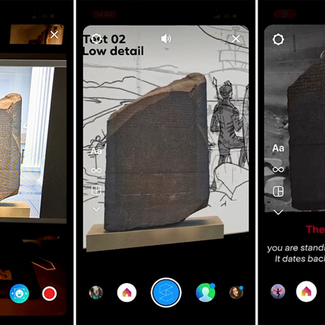
Radio & Audio Lions: Cannes 2022 Decoded
Dentsu Creative wins Grand Prix, Silver success for Grey London, R/GA London
21 June 2022
Dentsu Creative's 'The Unfiltered History Tour' for Vice Media landed the 2022 Grand Prix in the Radio & Audio Lions category.
Created by Dentsu Creative in Bengaluru and Mumbai, the campaign took the form of an immersive interactive mobile site and podcast series that presented artefacts in the British Museum from the perspective of their homeland communities.
Users were able to scan objects including the Rosetta Stone, Parthenon Marbles and Benin Bronzes to unlock an AR experience which stepped back in time to show when they were removed.
Meanwhile, Grey London was successful in the category, winning a Silver Lion for the 'Pringles Sonic Chip' work for Procter & Gamble's Pringles brand. R/GA London also won a Silver Lion, after partnering with The Guardian and Google to launch 'Auditorial', an accessible editorial platform.
Creative Salon caught up with Mariana O'Kelly, global executive creative director at Ogilvy and jury president for the Radio & Audio Lions judges, to hear her thoughts.
What were the key trends/reflections in the Radio & Audio category?
We witnessed almost a thousand entries from really big brands, using audio in interesting disruptive ways, proving the limitless potential of this category. We are seeing audio being used as NFTs, branded radio stations inside games (Grand Theft Auto), inside WhatsApp, on the product itself, and via augmented podcasts. Audio is not a traditional channel anymore. It is pervasive and organic in its use. The most used social platform right now is TikTok which is sound- based. Sharing happens on the basis of sound. The trends are based on sound. Thousands of UGC is based on sound.
But with the rapid integration of technology in everything we hear, say, touch and do, we wanted to make sure we choose a selection of work that opens up this category, not close it. That we don’t just award the latest and shiniest but protect the foundation this category was built upon. This is still the category that values great writing, the skill to charm its audience with words and language alone.
So, it was important for us to recognize and celebrate a diverse spread of work. We set ourselves a task to find a solid one, a traditional one, an integrated one, a crazy one, a purpose-driven one, a high tech one, a social one, to inspire a;; audio related work for the future, not just one type.
So you will see that our list of winners reflect this approach and that no one treatment, form or medium in this space was preferenced.
What advice would you give to marketers wanting to win a Lions in the category next year?
When you set up an insight or problem, show how the brand solved it. If you are entering anything in Audio Innovation, apply the same rigour you would for entering the Innovation category. Explain how the tech worked. How was it audio technology at the heart of it? Proof some sort of measurement or result. Prototypes are fine, but the jury needs more than just a creative write up.
Tailor your entries for the category you are entering. The jury will see through any sloppy entries and write ups. Yes, the write ups matter. We read it out loud and make sure the brand’s role is clear and relevant. Be honest, if it didn’t have mass reach, say it, and explain why it worked, even if it was for a niche audience of 15 people. Big ideas matter and the audio needs to be in the service of the big idea. If you enter a tactic, it needs to be damn good and disruptive to work. Juries favour platform ideas that build upon existing platforms.
What was your favourite work in this category?
I have never witnessed such a diverse set of entries. It was hard to judge them equally as they were all so different. They had nothing in common. So, all 22 metals we awarded had something in them we all loved, whether it was the insight, the bravery, the disruptive nature or just the love that came through the entry and case study itself. But our favourite work was the entries that combined all of these elements together.
Why did the Grand Prix winner win?
When we started our judging process, we gave ourselves a set of criteria. We wanted a piece of work that had a deep insight of a culture, place, or person. A big idea you can summarize in a tweet. Proper brand relevance, with the brand’s DNA integral to the idea, not just sandwiched onto the end. A platform idea that could be built upon, not just a tactic. Immaculate and immersive execution in the crafting of the language, the story, the emotion. An idea that couldn’t have worked without the audio component.
The Grand Prix winner ticked all of these boxes. It was brave and disruptive and seamlessly blended technology with deep cultural insightful storytelling. It engaged and deeply connected on a human level and demanded change on an issue nobody has ever tackled up until now. Delivered in the tone, attitude and world view of the brand. It had all the ingredients of a modern but yet timeless piece of work.







